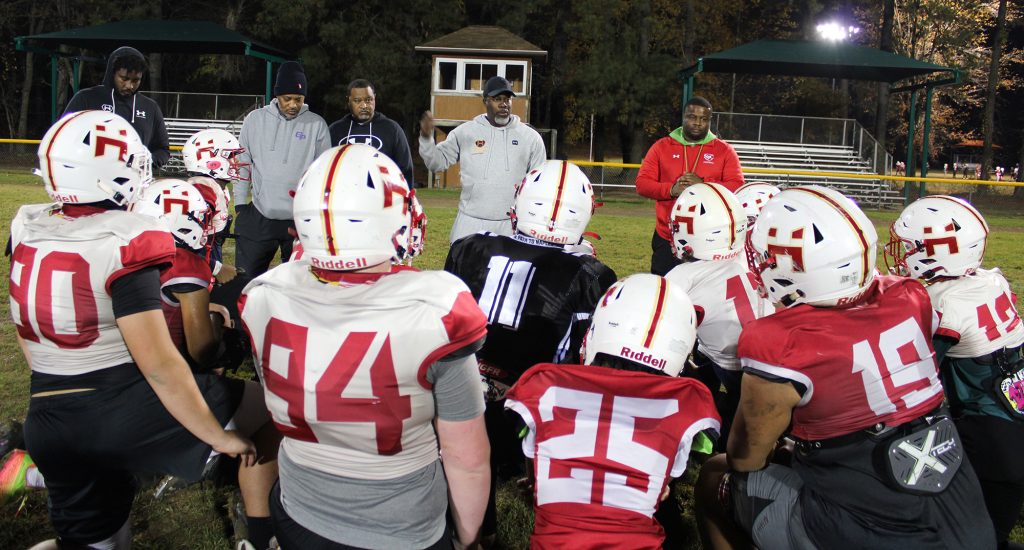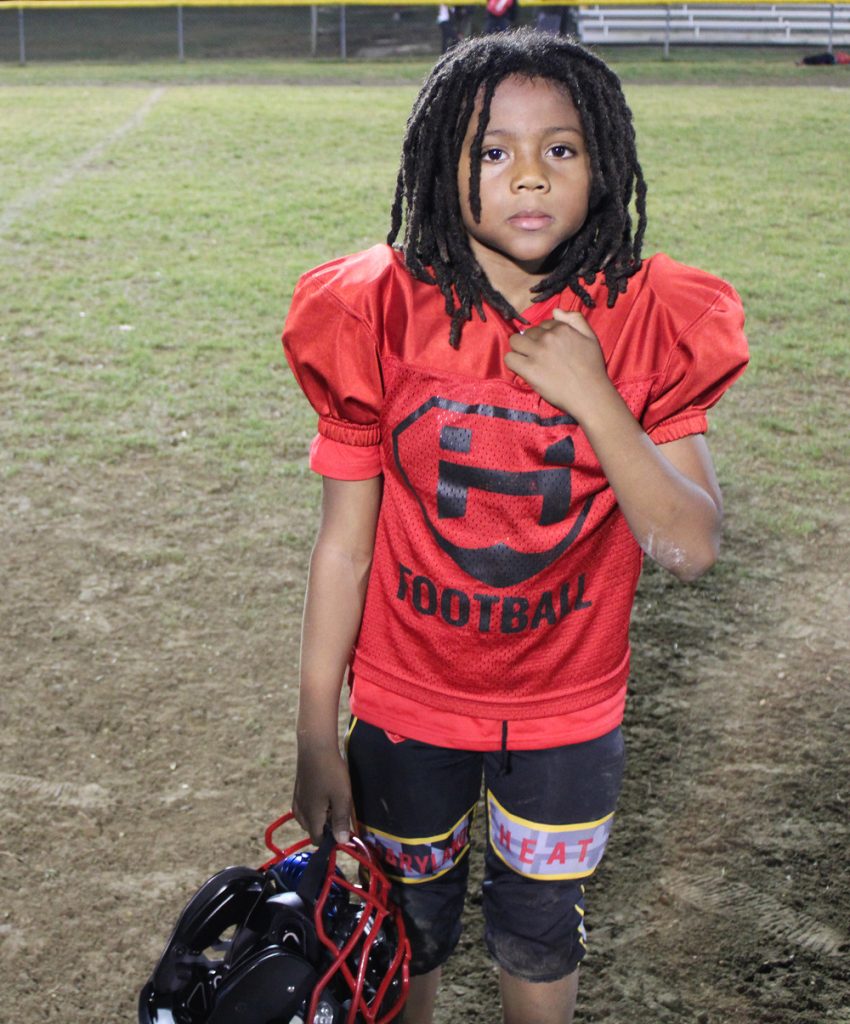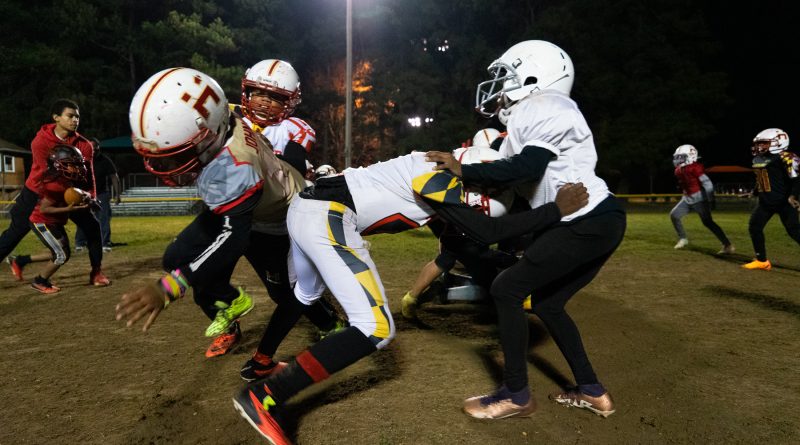Youth Tackle Football: Balancing risks and rewards depends on race and place
A four-month investigation by student journalists at the University of Maryland’s Shirley Povich Center for Sports Journalism and Howard Center for Investigative Journalism probes what parents know and how they make decisions about when – and if – their children should play tackle football.
In dozens of interviews with parents, coaches, youth players, medical researchers, former pro football players, and in reporting that includes an in-depth national public opinion poll of parents, the project reveals how tackle football represents opportunity in many communities. But decisions about whether to play vary by race and place.
That leaves families to balance the risks against the opportunities. Many are opting out. Participation in youth tackle football has been declining for years. However, in other communities, especially in communities of color, tackle football’s lure remains strong and the balance tips toward opportunity, a four-month investigation by The Shirley Povich Center for Sports Journalism and the Howard Center for Investigative Journalism at the University of Maryland has found.
Among the results of a Povich and Howard centers nationwide poll:
- Black parents are more likely than white parents, by substantial margins, to believe that youth tackle football could lead to a college scholarship or an NFL career. Hispanic parents are also far more likely than white parents to see college scholarships and pro careers as a potential benefit of youth football.
- Nearly one in four Black parents said the appropriate age for children to start playing tackle football is 9 years old or younger. Only 14% of white parents answered that children should start at age 9 or younger.
- Black parents are more likely than other parents polled to favor limiting contact in youth football practice to no more than 30 minutes per day.
Terrence Byrd is the president of Maryland Heat, a youth tackle program that suits up boys as young as 5 in pads and helmets. He said he knows injuries are possible in tackle football, as they are in all sports, and he added his coaches are training children to play as safely as possible. But he believes the opportunities that youth football provides outweigh the risks.
“I would confidently say that we are changing lives,” Byrd said.
Trauma to developing brains
Medical studies over the years have linked head trauma suffered by NFL players to a brain condition called chronic traumatic encephalopathy (CTE), with symptoms including dementia, depression, anxiety and aggression.
Last year, the Boston University CTE Center released a study that said the danger isn’t just to professional players. The developing brains of children are at risk for damage from repeated lower impacts to the head and brain, repeated impacts that have been associated with impulsive behaviors and cognitive problems in younger people.
The study notes that children who start playing tackle football at an early age or participate in the sport for more than 11 years run an increased risk of such impairment.
Though hitting in youth football is less violent than at high school and college levels, it can be damaging to developing bodies, researchers found. A child’s brain and head are disproportionately outsized for the rest of the body, especially from ages 5 to 8, and a child’s weak neck cannot brace for a hit the way an adult’s can, according to Dr. Robert Cantu, clinical diagnostics and therapeutics leader of the BU CTE Center and the author of more than 540 scientific articles on neurology and sports medicine.
Because youth necks are relatively weak, falling to the ground or turf and slamming a player’s head can cause concussions as often as collisions with other players, Dr. Cantu said. Even repetitive hits to the head that aren’t diagnosed as concussions can damage the brain, researchers found.
Not all researchers agree, leaving room for skepticism. A recent study of 52 high school athletes found head impacts were not consistently associated with changes in cognitive, emotional or behavioral symptoms.
Danielle Ransom, a pediatric neuropsychologist at Johns Hopkins All Children’s Hospital in St. Petersburg, Florida, and one of the study’s researchers, said the Boston University UNITE Brain Bank is “really important science.” BU’s Brain Bank is “the largest tissue repository in the world focused on traumatic brain injury (TBI) and CTE.”
But Ransom said that while head trauma contributes to CTE, other factors — including genetics and substance abuse — should also be considered.
At the University of Maryland, head football coach Michael Locksley said he feels the data is inconclusive and, “from a medical standpoint, the game has been under attack.”
“When you do the research, you can find the answers you want,” he said in an interview with the Povich and Howard centers. However, “It’s up to us as coaches and football people to figure out how to play it as safely as we can.”
Locksley went to Towson University on a football scholarship, becoming the first in his family to attend college. He met his wife, Kia, there and completed a marketing degree.
“The game has given me a lot,” he said.
But Locksley’s history with football is complicated. In 2017, his son Meiko, who began playing tackle football at 7, died in a shooting at age 25. His parents donated his brain for examination at the Boston University CTE Center. The doctors found that Meiko Locksley showed signs of CTE.

Mary Seau, the sister of Hall of Fame NFL linebacker Junior Seau, said she believes the research. Junior Seau started playing tackle football when he was 8. He went to the University of Southern California on a football scholarship, and his NFL career spanned 20 years.
In 2012, Seau shot himself dead in his home in Oceanside, California. After analysis of her brother’s brain found signs of CTE, Mary Seau said her family thought about his Pop Warner youth tackle football years.
“We didn’t realize that the brain is so fragile,” Seau said.
Though members of her family are still involved with the sport today, she doesn’t watch football anymore. “I have my nieces and nephews who can’t talk about how their son played because they know how I am,” Seau said.
Benefits beyond the playing field
Some supporters of youth football believe injuries can be reduced if coaches continue to limit the number of hits allowed during practices, saving more contact for the game. The Ipsos poll found 71% of parents — 67% of white parents and 77% of Black parents — agreed with “limiting full-contact practice for youth tackle football to no more than twice per week.”
Some parents are opting to enroll their children in leagues that play flag football, which limits contact on the field. Others believe players should not be introduced to tackle football until high school.
But youth tackle leagues remain popular in many parts of the country. Todd Casey, commissioner of Vienna (Virginia) Youth, Inc. Football, said enrollment has steadily increased in the football program. “Right now, we have our largest enrollment in tackle football that we’ve had since 2014,” he said.
In Fort Washington, Maryland, parents who were watching the Heat practice said they’ve considered the dangers and believe the risk of injury is no greater in football than other sports. They said coaches are careful to keep their children safe and the players are gaining a lot from the game, with benefits accruing far off the field.
“They make new friends, experience new things,” Stephanie Rogers said on a fall evening as she watched her son, DeCarlo, 15, and his Maryland Heat teammates run through plays. “The sum of those types of benefits that aren’t necessarily the winning-the-game part, but you know what they get out of it.”
Beyond the social benefits, Rogers said, the Heat program provides opportunities for a better education. “We have private high schools trying to get these kids in their doors,” she said.
DeMatha Catholic High School in Hyattsville, Maryland, is one of the private schools that recruits Maryland Heat players. Last year, 19 of DeMatha’s football players signed with Division I and II college football programs. Tuition is $21,900, said Bill McGregor, DeMatha’s football coach. The school does not offer athletic scholarships, he said, but families can apply for financial aid.
At the Heat practice, two parents had driven from Delaware and another from Lancaster, Pennsylvania, a trip of more than two hours, which the parent makes three times a week.
“You’re now changing the education paradigm for young men,” said Byrd, the coach, “and you’re changing their exposure to colleges,” by giving the players experience that can attract scholarships.

Some Heat players’ parents can afford to pay steep prices for equipment, but some families can’t afford to pay the program’s $250 flat fee — which includes equipment — to participate for the entire season. In some cases, the program raises money to cover those children’s fees.
Jerome Montgomery, of Waldorf, Maryland, researches the safest equipment for his son Micah’s practices — from pads to helmets. Montgomery said helmets can run up to $700 each.
“I’d rather pay a lot of money for the helmets than for a hospital visit,” he said.
The risk of injuries, Byrd said, exists in all sports. And many of the children in his league face dangers off the field — “whether it’s at risk for taking a shot to the head at a football game, or whether it’s at risk to taking, you know, a shot on the streets.”
Considering the risks
Rogers, a nurse, said she knows the risks of football. “I used to work in the operating room. I know a lot about head trauma and mental health issues that can stem from trauma. … I guess you always have that in the back of your mind.” But the worry is “not enough to not let them play.”
Rogers added she trusts the quality of the equipment and appreciates Byrd’s dedication to including safety precautions in practice.
Shakia Johnson’s son, Nasir, 15, has had injuries: a broken leg, hyperextended knees, other aches and pains. His parents take him to a chiropractor and he does cryotherapy and yoga. “We actually invest a lot in his body,” Johnson said.
His teammate, Phyve Linder, 14, started playing tackle football at 5. He’s recovered from an ankle injury that happened when he made a tackle. And he said last year he saw a player taken off the field with a concussion.
He said that didn’t bother him. “I still wanted to play because I love the game. I love playing the game. It didn’t really change my mind at all because I’ve seen it multiple times,” Linder said.
Though flag football may be a safer alternative, Mac Stephens, former NFL player and coach at Cleveland Heights High School in Ohio, said he doesn’t believe this substitution would work for the majority of parents in urban areas.
If Cleveland Heights didn’t offer tackle football before high school, Stephens said, parents would find leagues in other towns for their kids to play in.
Parents, he said, believe, “Well, I have to get my son on track to get a college scholarship someday.”
Stephens, co-president of the North Coast Youth Football Conference, said the Cleveland-based league is 90% to 95% Black and is thriving, with several of its teams seeing an increase in participation.
Another former NFL player takes a different view. Solomon Brannan, who played in the first Super Bowl (then called the AFL–NFL World Championship Game), in 1967, said flag football could teach young players about teamwork and strategy just as well as tackle, and with far fewer risks.
A former head coach at Morris Brown College and assistant coach at Morehouse College, Brannan has marched with several organizations to Capitol Hill as part of Brain Injury Awareness Month in March to highlight the dangers of the sport.
A financial factor
Money, Brannan said, motivates parents who are hoping for scholarships. But instead of focusing on athletics, he said, parents should be spending time with their kids and books.
“You can’t depend on sports,” Brannan said, “but if you’ve got it upstairs in your head, you’re going to be successful no matter what.”
Dr. Samantha Bureau, director of international programs at the Concussion Legacy Foundation, said that deciding to play tackle football does not mean players are indifferent about their health.
“I just think some people maybe are not as fortunate to be thinking about their long-term health in the current moment based on their current situation,” she said.
At the University of Maryland, Michael Locksley said his wife, Kia, now believes children should not play tackle football before 14. But Michael Locksley disagrees.
Football, he said, “is the closest sport to mimicking life. In football, you get knocked down. You can get tackled, and you’ve got to get back up and you’ve got to face it the next play.”
If his grandchildren want to play the game, Locksley said, he will support them. But it’s their parents who will decide if the kids will suit up and play tackle.
Please read the Poll story.
Data: Sapna Bansil and Ben Reitman
Digital Design and Graphics: Abbi Ross, Sapna Bansil, Freddy Wolfe, Christine Folivi and Judith Altneu
Photography: Freddy Wolfe, Torrence Banks, Andrew Chodes, Jack Rothenberg and Jenna Bloom
Video: Jenna Bloom, Sapna Bansil and Jack Rothenberg
Editors: Mark Hyman, Sandy Banisky, Kathy Best, Derek Willis, Kevin Blackistone, Adam Marton, Josh Land, Nathan Stevens, Kaitlyn Wilson, Sean Mussenden, Stacey Decker and James R. Carroll

Capital News Service is a student-powered news organization run by the University of Maryland Philip Merrill College of Journalism. With bureaus in Annapolis and Washington run by professional journalists with decades of experience, they deliver news in multiple formats via partner news organizations and a destination Website.

